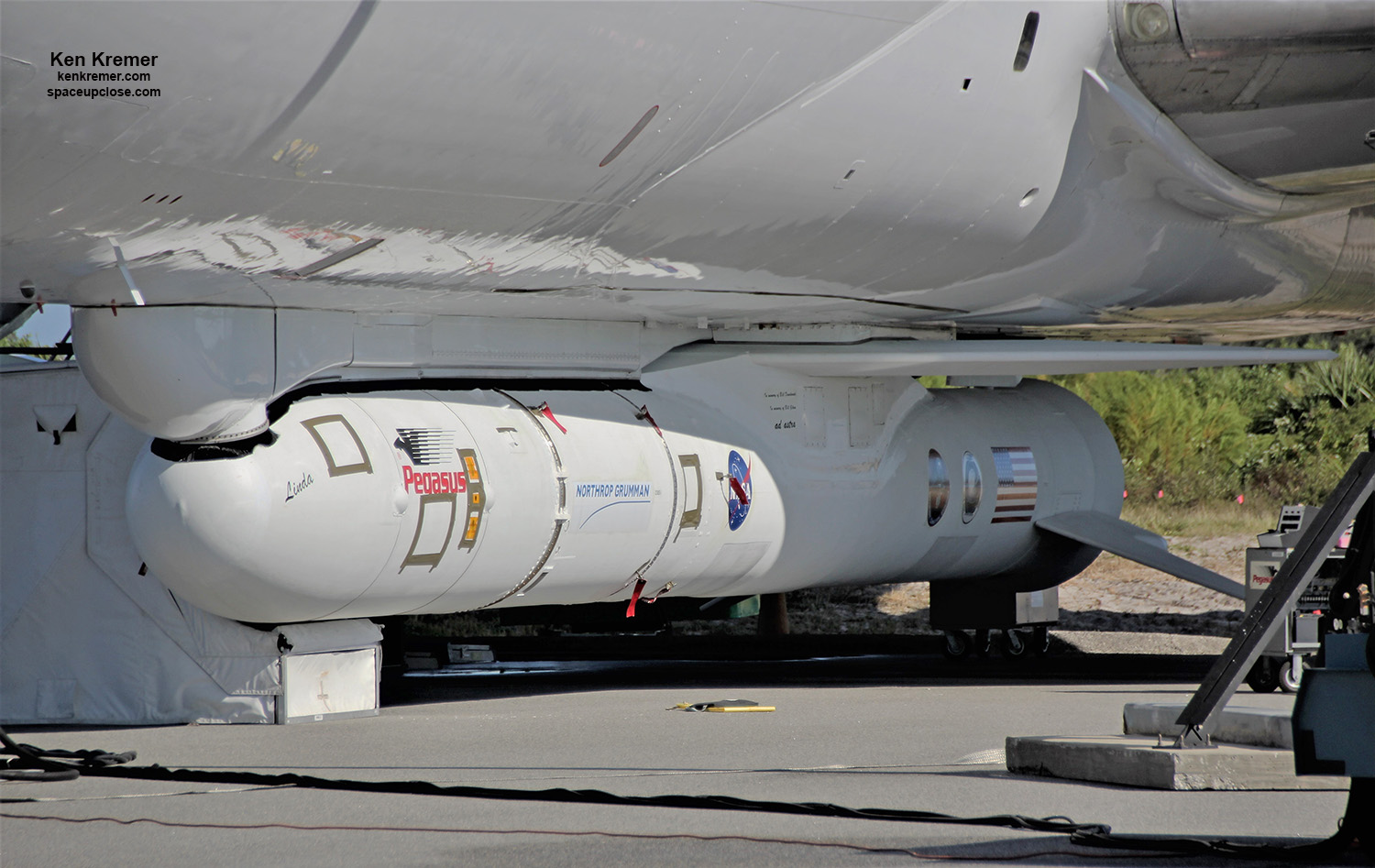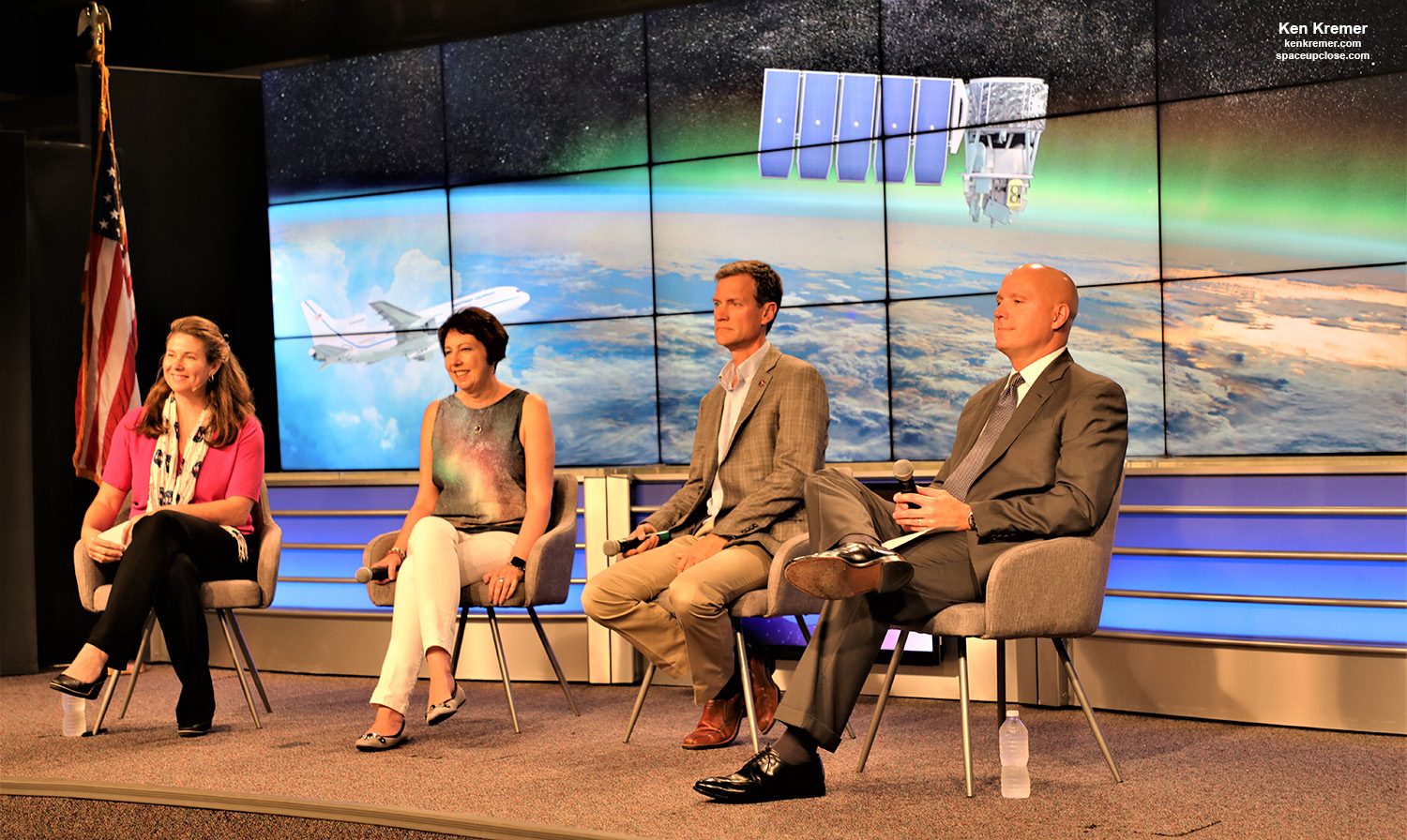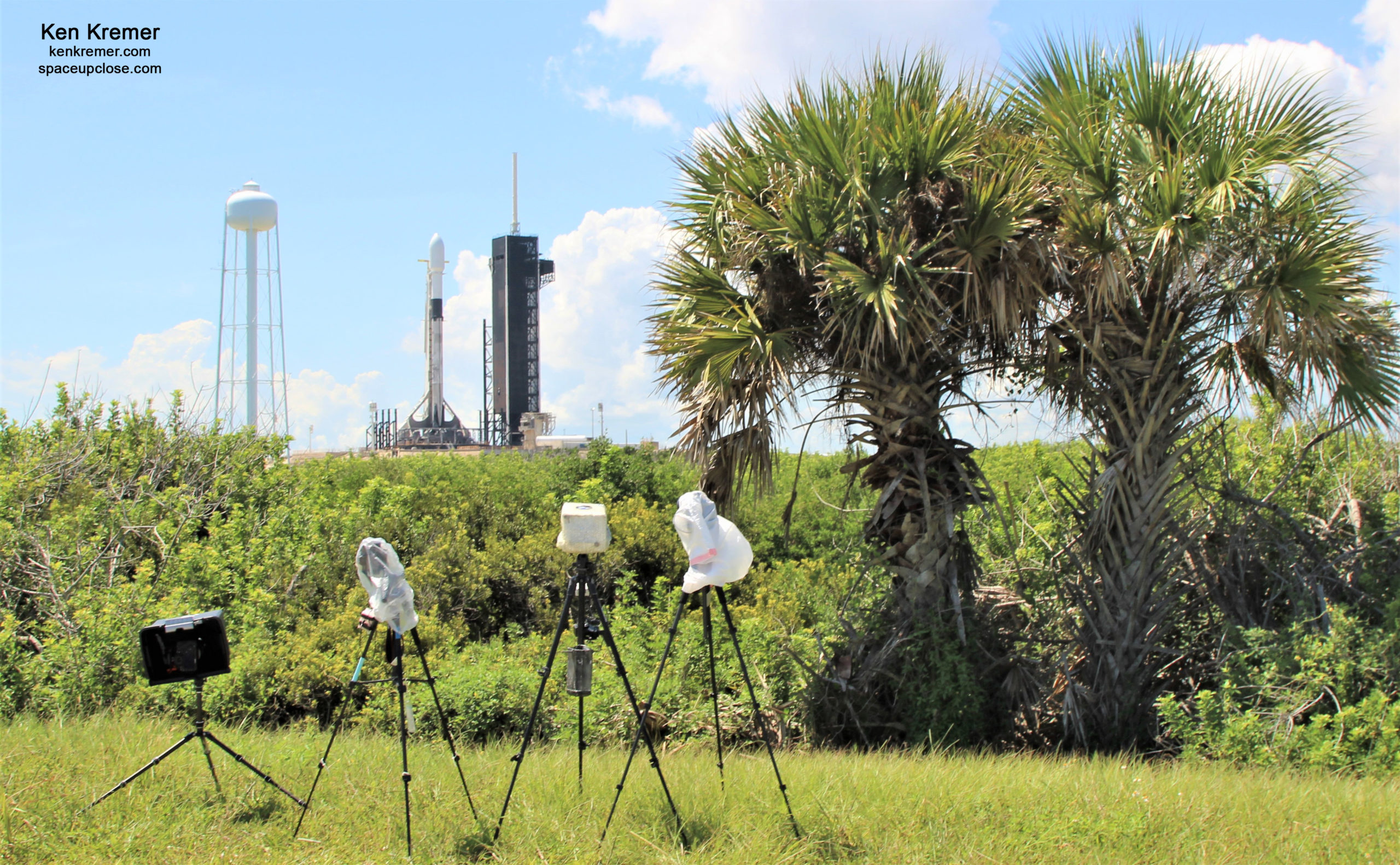
KENNEDY SPACE CENTER & CAPE CANAVERAL AIR FORCE STATION, FL –NASA’s newest science mission named ICON launched at last tonight, Oct. 10, to begin the most detailed study ever of Earth’s ionosphere – the tenuous upper atmospheric layer at the interface of the dynamic boundary where Earth’s weather meets space weather – via an air-drop launch of the Northrop Grumman Pegasus XL carrier rocket from the world’s last flying L-1011 Stargazer aircraft – from the Florida Space Coast after a lengthy two year delay to resolve technical issues with the rocket.
Furthermore after another 24 hour launch delay due to horrible Space Coast weather from Wednesday, Oct. 9 to Thursday evening, Oct. 10, there was still more drama to the very end as to whether NASA’s Ionospheric Connection Explorer (ICON) launch on the Pegasus XL rocket would even launch tonite when a dramatic abort was called at the last moment T Minus minute when communications were lost between the Stargazer flight crew and the ground team at Cape Canaveral Air Force Station in Florida.
Finally after the Stargazer flight crew flew the last of its kind aircraft around in a race track pattern to set up a second try they successfully deployed and launched NASA’s ICON spacecraft Thursday night at 9:59 p.m. EDT Oct. 10 to low Earth orbit for a first-of-its-kind mission “to study a region of space where changes can disrupt communications and satellite orbits, and even increase radiation risks to astronauts” says NASA.

Watch this NASA video of the Pegasus air drop launch of ICON:
Video Caption: Launch of Pegasus XL Carrying ICON. The Northrop Grumman Pegasus XL rocket carrying NASA’s Ionospheric Connection Explorer (ICON) launches from the company’s L-1011 Stargazer aircraft on Oct 10, 2019 at 9:59 p.m. EDT. ICON is embarking on a mission to study the dynamic zone high in Earth’s atmosphere where terrestrial weather from below meets space weather above. Credit: NASA TV
Tonight’s ICON launch attempt began in earnest after Northrop Grumman’s Stargazer L-1011 aircraft took off at 8:31 p.m. EDT (0031 GMT) from Cape Canaveral Air Force Station in Florida carrying ICON, on the Pegasus XL rocket attached to the belly.
Space UpClose was on hand at the Skid Strip to witness the takeoff first hand which took place on time after rain showers moved on.
Enjoy our Space UpClose photo gallery of streak shots and stills of the takeoff, the Pegasus XL rocket encapsulating ICON and the L-1011 Stargazer direct at the Skid Strip.

The crew flew Stargazer to the targeted launch box located about 100 miles due east of Daytona Beach off Florida’s east coast to
the launch altitude of about 39,000 feet over the Atlantic Ocean – with a Pegasus deployment targeted for about 1 hour later at 9:30 p.m.

However, the team skipped that first launch opportunity at the last moment due to communication issues between the ground team at Cape Canaveral and the aircraft.
Fortunately, two launch opportunities were available this evening – as the flight crew told me in a pre-launch interview at the skid strip.
On the second attempt, the aircraft crew released its payload at 9:59 p.m. EDT and automated systems on the Pegasus rocket launched ICON into space.

NASA’s $252 million Ionospheric Connection Explorer (ICON) research satellite mission is nestled inside the nose cone of the Pegasus XL rocket that’s cradled at the belly of the Northrop Grumman L-1011 carrier jet named ‘Stargazer’ – the very last of its kind still flying in the world.
The spacecraft’s 5 segment solar panels successfully deployed at approximately 10:36 p.m. EDT confirming it has power with all systems operating healthy.
After an approximately month-long The ICON commissioning period will take about one month and thereafter it will begin sending back its first science data in November, says NASA.

During a baselined 2-year-long mission, ICON will explore the turbulent upper atmospheric ionosphere zone at the interface between the Earth’s terrestrial weather below and space weather above where giant winds whip up the particles – ionized by solar radiation.
The ionosphere — a dynamic region of Earth’s upper atmosphere loaded with charged and neutral particles is home to colorful auroras like the Aurora Borealis or northern lights, hundreds of critical communication satellites, and astronaut crews living 24/7 aboard the International Space Station (ISS).
“The ionosphere is continually changing, and it’s very dynamic, so that can have big impacts on our ability to do this kind of communication,” said Nicky Fox, head of NASA’s heliophysics division at NASA HQ at the Oct. 9 prelaunch briefing at NASA’s Kennedy Space Center in Florida.
“So not only is it a great place to go and study plasma physics, but it’s also a region that has a big space weather impact on us.”

ICON will study the ionosphere – “the mixed layer of charged and neutral particles extending from about 50 to 360 miles above Earth’s surface, through which radio communications and GPS signals travel, and the processes there that can distort or even disrupt these signals. Knowledge gleaned from this mission will aid in mitigating its effects on satellites and communications technology worldwide.”
The ionosphere is a “dynamic zone high in Earth’s atmosphere can be a source of great beauty such as the aurora, but can also be disruptive to radio communications and satellites and astronaut health. ICON will help determine the physical processes at play in this “frontier of space,” thus paving the way for mitigating their effects on our technology, communications systems and society.”
“ICON has an important job to do – to help us understand the dynamic space environment near our home,” said Fox, in a post launch statement. “ICON will be the first mission to simultaneously track what’s happening in Earth’s upper atmosphere and in space to see how the two interact, causing the kind of changes that can disrupt our communications systems.”
ICON is encapsulated inside the Pegasus nose cone. The rocket is 57 feet (17 meters) long, 4.2 meters wing diameter and weighs 52,920 pounds (24,000 kg).
The cylindrically shaped spacecraft is about a meter in diameter. It is powered by a single 5 panel solar array that when deployed extends to the length of a door – 8 1/3 feet long and 2 ¾ feet wide.
Overall this mission marks the 44th launch of Pegasus XL since the maiden flight in 1990.
The last Pegasus launch took place in December 2016 for the launch of NASA’s $157 million hurricane forecasting mission CYGNSS. Space UpClose was on hand – my photos below.
Pegasus XL was the world’s first air-launched rocket launching satellites to orbit. It utilizes the L-1011 carrier aircraft as an “air-breathing reusable first stage” according to Northrop Grumman.

ICON is a NASA Explorer class mission managed by NASA’s Goddard Space Flight Center, Greenbelt, MD.
The Northrop Grumman team told me they hope to win contract to launch additional Pegasus rockets and have parts for about one and a half rockets in inventory.





